
The Hidden Cost of Spreadsheets
Why growing teams are moving beyond spreadsheets to manage work
October 2025
Executive Summary
Spreadsheets are a foundational tool, but they weren’t built to manage today’s pace of work. As teams scale and workflows expand, the limitations of spreadsheets become more difficult to ignore. This report explores the tipping points at which teams begin to look for something better, why some don’t, and what makes other teams stop patching recurring problems and start planning for scale.
Based on original research from a 2025 survey of professionals across company sizes and industries, we identified the most common tipping points that prompt teams to explore work management tools. These solutions are not necessarily a spreadsheet alternative, but they build on the strengths of these classic tools. Work management tools are purpose-built platforms that help teams coordinate projects, automate repetitive tasks, connect data across systems, and provide visibility at every level of an organization.
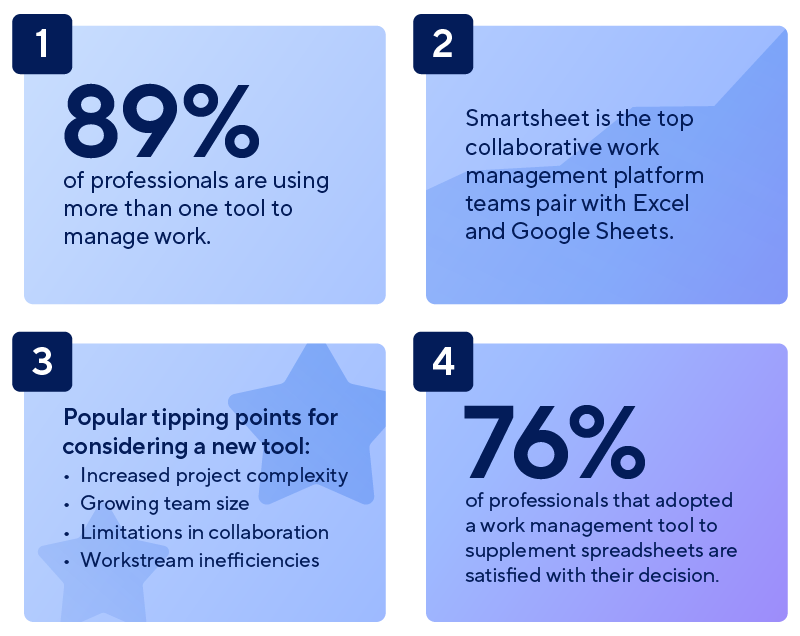
The State of Spreadsheet Use in 2025
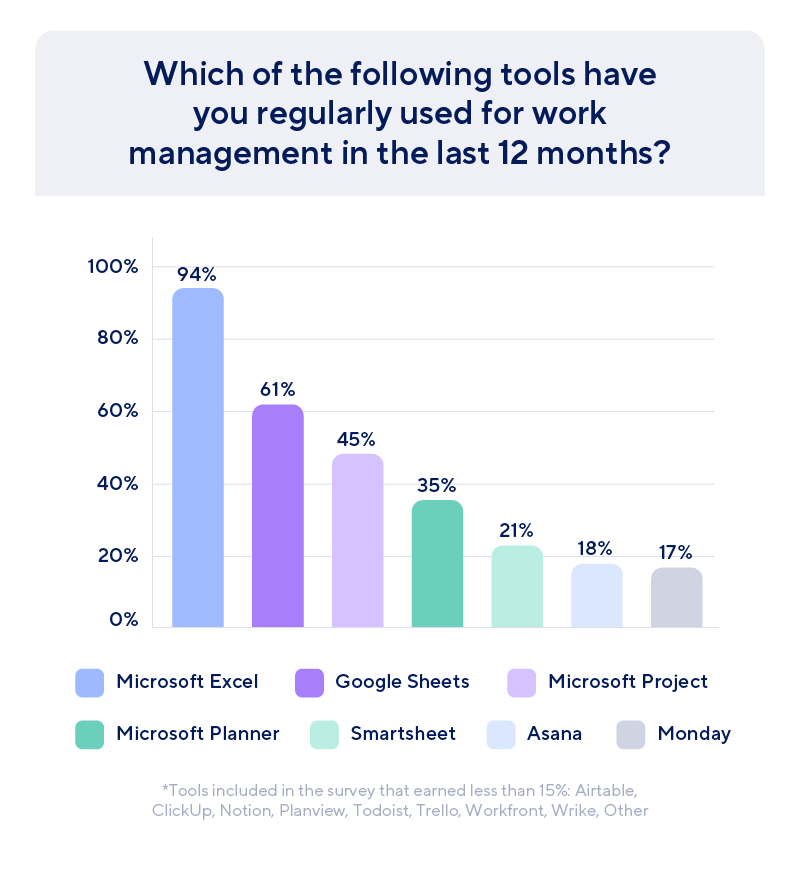
Spreadsheets remain one of the most trusted tools in business. The majority of professionals surveyed (94%) use Excel regularly, and more than half (61%) say they use Google Sheets regularly. Despite their widespread use, few teams rely on spreadsheets alone. As teams coordinate across time zones, launch more complex initiatives, and manage increasingly cross-functional workflows, it’s not surprising that 89% are using more than one tool to manage work today.
Spreadsheets are versatile tools, which makes them a natural starting point for nearly any kind of work: budgeting, reporting, data analysis, task tracking, process management. But as you’ll see in this report — and probably experienced yourself — there are disadvantages to relying only on spreadsheets, especially when work becomes more complex, collaborative, and urgent. A tool that was originally designed for calculations is being stretched to manage everything.
What is it exactly about spreadsheets that’s holding your team back from their full potential?
What Spreadsheets Are Really Costing Your Team
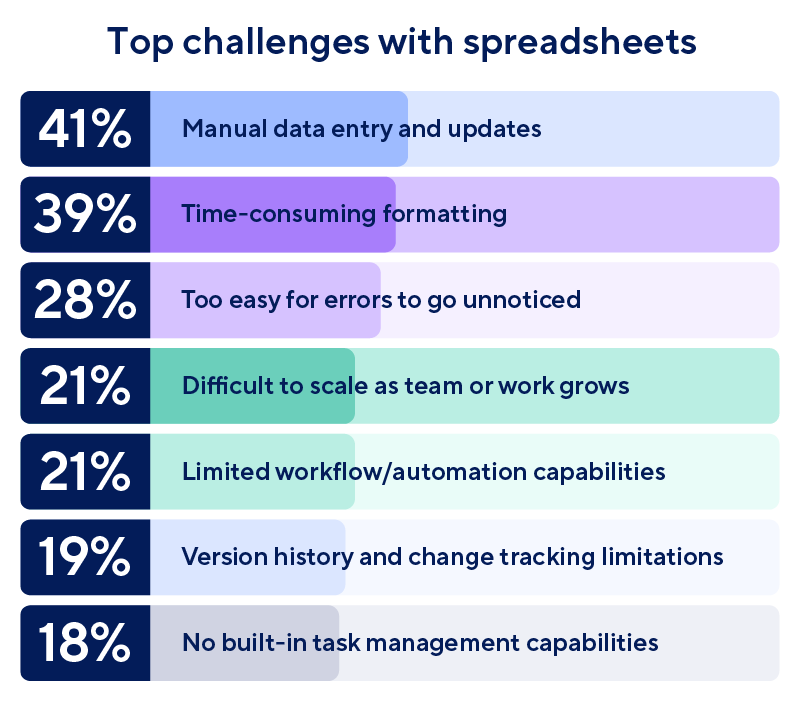
Managing work in spreadsheets creates more work and more risk. Beyond the time spent formatting cells, double-checking formulas, and manually tracking updates, the bigger cost lies in errors that slip through unnoticed. Even with careful manual reviews, only about half of those mistakes are typically caught, which leaves teams exposed to errors that can undermine accuracy, decisions, and results.
When we asked professionals about the tactical disadvantages of using spreadsheets, the top frustrations were clear → Information is spread across systems, feedback gets lost in emails and comments, and it’s not always clear what has been changed or what still needs to be done. As work grows more complex, teams find themselves spending more time maintaining their tools than actually using them to move work forward.
Limitations of Spreadsheets: Common Tipping Points
As organizations grow, there is more pressure to scale, automate, and bring greater structure to how teams work together. Spreadsheets, while still useful, weren’t built for managing large teams, multiple functions, or complex workflows. At a certain point, teams begin looking for tools that provide better visibility, more automation, and smoother processes.
Project complexity and growing teams are the most common reasons that teams look for new tools. Depending on the size of the business, tipping points compound to include factors such as the need for better integration or automation as teams move beyond exploration and into the consideration phase of adopting a new tool, all in addition to simply experiencing limitations with their current tools. When teams are hitting these inflection points, they’re looking for tools that work with spreadsheets and can help them do more.
Find out how Smartsheet integrations connect with the tools you already use.
Why Teams Stick With Spreadsheets
What teams believe | What the data shows | The reality |
|---|---|---|
| We’re generally satisfied with spreadsheets. | Only half (49%) of teams using Excel and Google Sheets and not considering alternative tools are generally satisfied with spreadsheets. | General satisfaction is masking inefficiencies. |
| Spreadsheets are flexible enough for what we need. | Top challenges include manual updates (45%), formatting issues (36%), and undetected errors (31%). | Flexibility is creating hidden friction and extra work. |
| It’s too hard to get approval for a new tool. | Only 22% say it would be very or extremely difficult to get approval. | The real challenge isn’t approval, it’s starting the conversation. |
| Switching tools takes too much time and effort. | 76% of teams who adopted an alternative are satisfied. Trials lead to higher adoption too. | You don’t need to completely replace spreadsheets. Start with one workflow to layer work management into. |
| Everyone already knows how to use spreadsheets. | Ease of use and time savings are top drivers of switching. | Purpose-built tools with spreadsheet-like interfaces make adoption of a new tool easier, and they deliver greater ROI. |
What Makes Teams Finally Adopt Work Management Tools
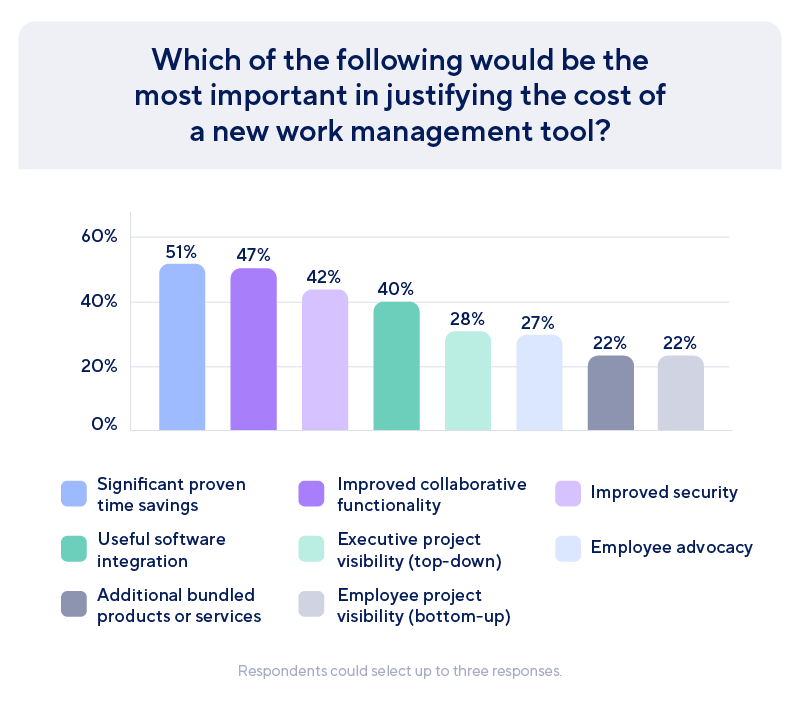
For many teams, moving from spreadsheets to a more capable tool isn’t an overnight switch — it’s a gradual process. As teams grow, workflows get more complicated and collaboration becomes more challenging. These factors often lead to a moment where leaders realize they need to scale their processes, not just their headcount. The 2025 PPM Priorities Report uncovered that 99% of PPM professionals said that better tools — those with data, automation, and collaboration capabilities — are critical to adapting effectively to change.
It’s not the problem that drives the decision — it’s the promise of something better. When teams switch to a new tool, three out of four professionals say they are happy with the results. A big reason for that is the ability to do more with data analysis (44%).
Participating in a trial or pilot can make all the difference. Among those who adopted and stuck with an alternative tool, 68% participated in a trial first. Those who did were more likely to adopt the tool and were more satisfied with their decision. In fact, 76% of respondents who adopted a new tool report being satisfied with their new solution, showing that hands-on experience is a powerful way to build confidence, reduce hesitation, and prove the tool’s value early on.
ROI is another important factor when it comes to adopting a work management tool to supplement spreadsheet use. When thinking about justifying the cost of a new work management tool, approximately half of respondents (51%) said that significant proven time savings is the most important factor. Improved collaboration and security were two other important motivating factors.
At the end of the day, what makes a work management tool stick is what the features unlock: more time for strategy, smoother collaboration, and better visibility at every level of the organization.
Learn more about purpose-built features for managing complex work and enterprise-grade security you can trust.
How to Start
Practical Advice for Layering in a Work Management Tool
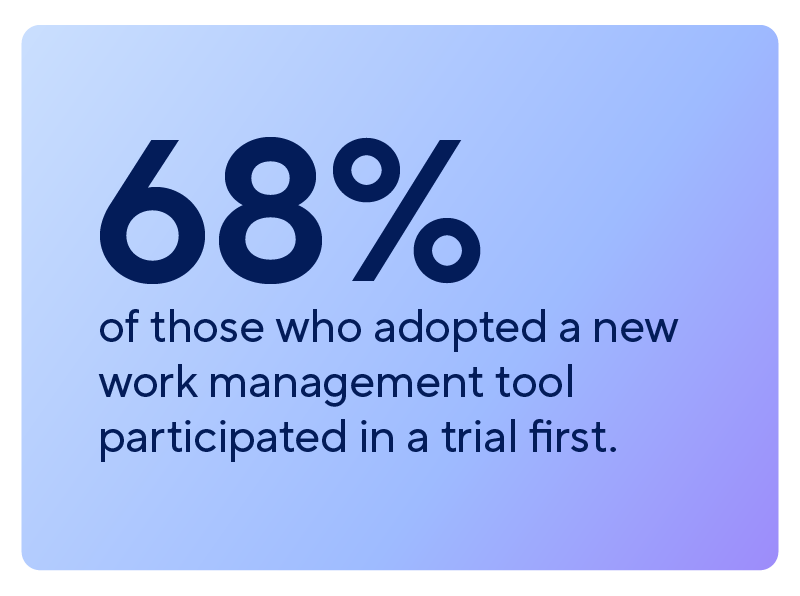
If you’re feeling the frustrations of managing work in spreadsheets, you’re not alone. Many teams have been in this situation before. Start small and scale smart by layering in a work management tool alongside spreadsheets. This helps team members build confidence with the new tool, eases pushback, and demonstrates real value right away.
Tips for layering in a work management tool:
- Identify a high-friction workflow (these are often manual with extensive cross-functional collaboration or dependent on external data sources) and test a new way of working through it outside of a spreadsheet.
- Look for tools that integrate with Excel and Google Sheets and that can import data from spreadsheets (or even have a similar look and feel to them).
- Run a pilot or trial to test features, gather feedback from your team, and show how the tool can save time.
- Track metrics such as hours saved, reduction in errors, or how quickly information can be shared to prove value early on.
- Share your learnings with stakeholders and collect input from different departments, especially those most likely to benefit from the new tool.
Spreadsheets Got You This Far. What’s Next?
As teams grow, projects scale, and workflows evolve, the limitations of spreadsheets become harder to ignore and the opportunity cost of sticking with “good enough” gets bigger. As the research shows, most teams aren’t looking for a spreadsheet alternative — they’re looking to supplement their spreadsheets with structure, automation, collaboration, and visibility.
A purpose-built work management tool, such as Smartsheet, can be that next layer to help teams evolve beyond spreadsheets, one step at a time. For teams feeling the strain of growing complexity, the tipping point isn’t failure — it’s a sign of success. It means your work is expanding, your impact is increasing.
Smartsheet is an intelligent work management platform that unites people, data, and AI to reduce manual effort, streamline reporting, and give teams the visibility they need to move faster without losing the flexibility they’ve come to rely on. Used by 85% of the Fortune 100, Smartsheet offers enterprise-grade security and scale, empowering teams and leaders to move beyond workarounds and achieve smarter outcomes, faster.
You don’t need to replace every spreadsheet or reinvent your entire process to get started. Begin with one workflow, experience the difference, and build from there. The right platform won’t just support your work — it will accelerate it.
Methodology
The research showcased in this report was designed to uncover the benefits and challenges of spreadsheet-based processes, identify widespread challenges, and highlight the tipping points that lead teams to explore supplemental work management tools. The study was completed in two phases: an initial qualitative phase, followed by a large-scale quantitative survey.
In Phase 1, Smartsheet conducted 16 in-depth interviews with small to medium-sized business (SMB) respondents (50–200 employees) across three segments of spreadsheet usage. These conversations helped establish a foundational understanding of the challenges and guided the survey design.
In Phase 2, we surveyed more than 650 professionals across SMB, midmarket, and enterprise organizations, again spanning three usage segments. This quantitative phase provided statistically meaningful insights that validated and expanded upon the qualitative findings. Together, these phases offer a comprehensive view of when and why organizations begin to look beyond spreadsheets, ensuring that the insights in this report reflect both lived experiences and broader market trends.


